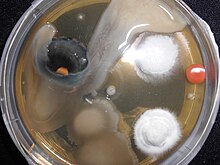Applications of Sterilization
- Sterilization is used in the preservation of foods and liquids, such as canning and ultra-high temperature processing.
- It is crucial in medicine and surgery to ensure the sterility of surgical instruments, medications, and medical devices.
- Sterilization techniques are also employed in the sterilization of spacecraft components to prevent contamination of Solar System bodies.
- Sterilization is used to reduce initially present microorganisms or potential pathogens in various applications.
- The degree of sterilization is commonly expressed by the decimal reduction time (D-value), which indicates the time needed to reduce the initial number of microorganisms.
Sterilization in Food Preservation
- Nicolas Appert discovered that applying heat to foods and liquids slows their decay, leading to longer preservation for safe consumption.
- Canning of foods is an extension of this principle and has contributed to reducing foodborne illnesses.
- Other methods, such as ultra-high temperature processing, food irradiation, and high pressure sterilization, are also used in food preservation.
- Sterility in the context of food refers to commercial sterility, which means the absence of microorganisms capable of growing in the food under normal non-refrigerated conditions.
- The Codex Allimentarius provides guidelines for the distribution and storage of food to maintain commercial sterility.
Sterilization in Medicine and Surgery
- Sterility is essential in surgical instruments, medications, and medical devices that enter aseptic parts of the body or are used in parenteral pharmaceuticals.
- Steam sterilization is commonly used for medical and surgical devices, but low-temperature sterilization methods have become necessary for materials like plastics.
- Ethylene oxide gas has been used since the 1950s for heat- and moisture-sensitive medical devices.
- New low-temperature sterilization systems, such as vaporised hydrogen peroxide and peracetic acid immersion, have been developed in recent years.
- The United States Food and Drug Administration (FDA) requires a sterility assurance level of at least 10 for high-risk applications in medical devices and injections.
Sterilization in Spacecraft
- Strict international rules are in place to prevent the contamination of Solar System bodies from biological material from Earth.
- Sterilization techniques used in spacecraft components depend on the type of mission and its destination.
- Techniques like heating, chemical sterilization, oxidization, ultraviolet, and irradiation are employed, as many spacecraft components cannot withstand high temperatures.
- The requirements for sterilization become stricter for planets considered habitable.
- The goal is to prevent the introduction of microorganisms that could potentially survive and thrive in other planetary environments.
Quantification of Sterilization
- The aim of sterilization is to reduce the number of microorganisms or potential pathogens present.
- The degree of sterilization is expressed by the D-value, which represents the time required to reduce the initial number of microorganisms to one tenth of its original value.
- The D-value varies depending on sterilization conditions, type of microorganism, temperature, water activity, pH, etc.
- To ensure sterility, the overkill method is often used, which involves sterilizing for longer than necessary to kill the bioburden present.
- High-risk applications, like medical devices and injections, require a sterility assurance level of at least 10 according to the FDA.
Sterilization (British English: sterilisation) refers to any process that removes, kills, or deactivates all forms of life (particularly microorganisms such as fungi, bacteria, spores, and unicellular eukaryotic organisms) and other biological agents (such as prions or viruses) present in or on a specific surface, object, or fluid. Sterilization can be achieved through various means, including heat, chemicals, irradiation, high pressure, and filtration. Sterilization is distinct from disinfection, sanitization, and pasteurization, in that those methods reduce rather than eliminate all forms of life and biological agents present. After sterilization, an object is referred to as being sterile or aseptic.
